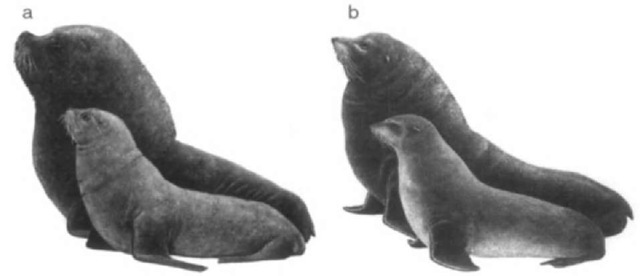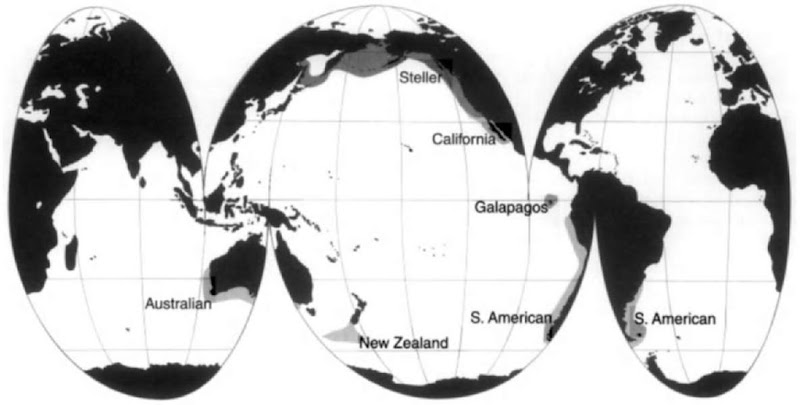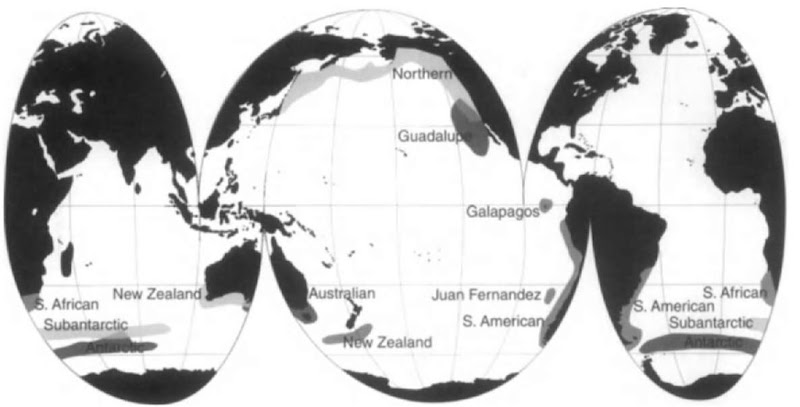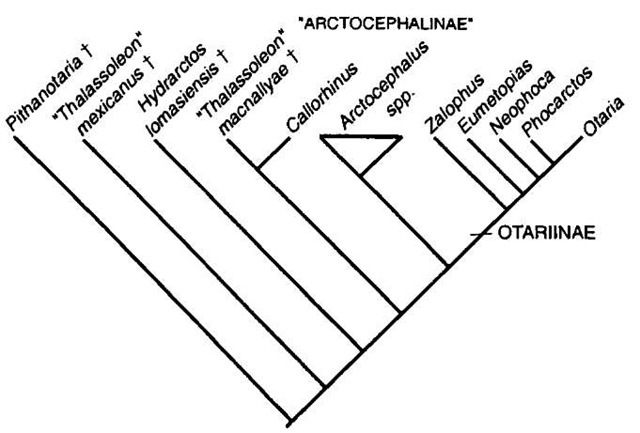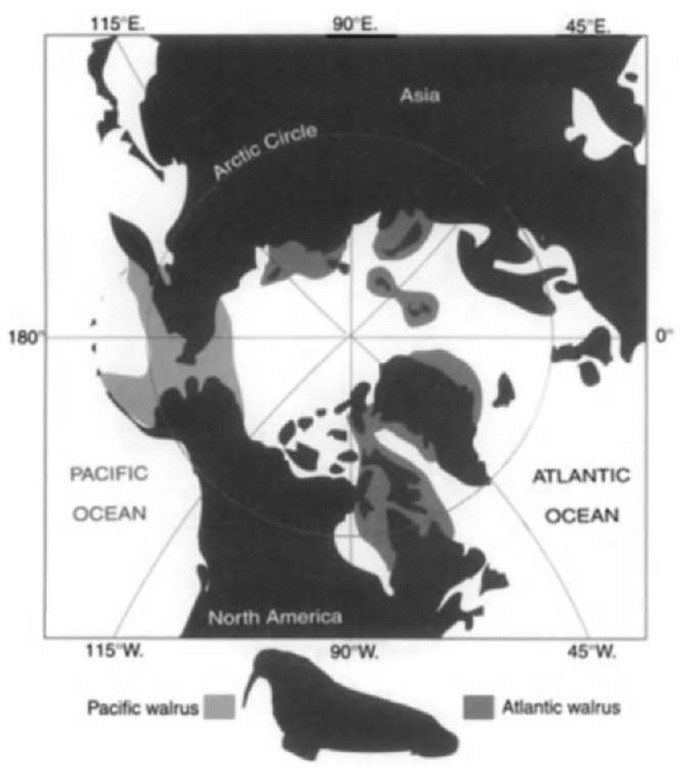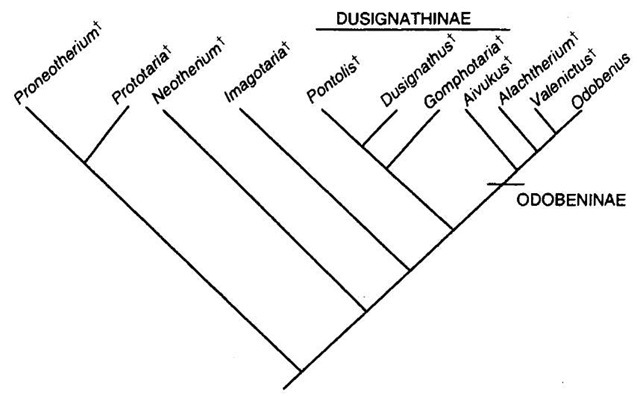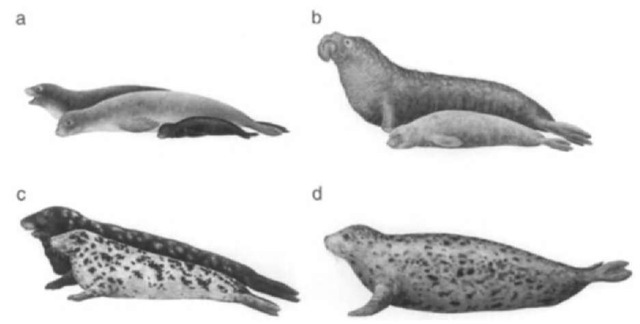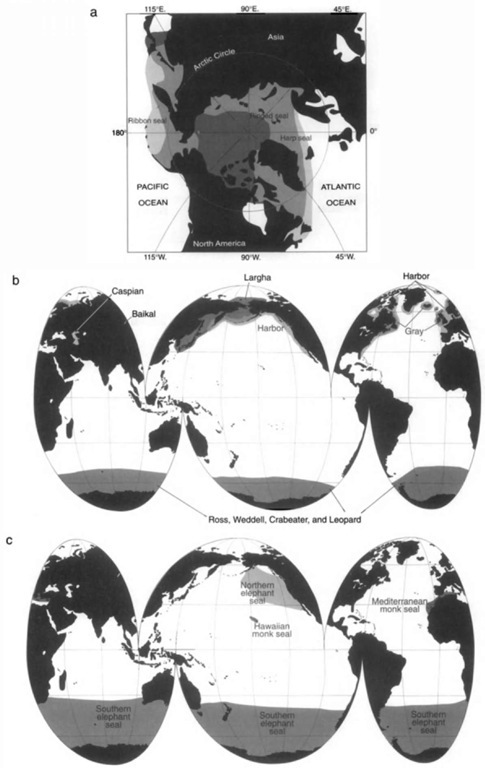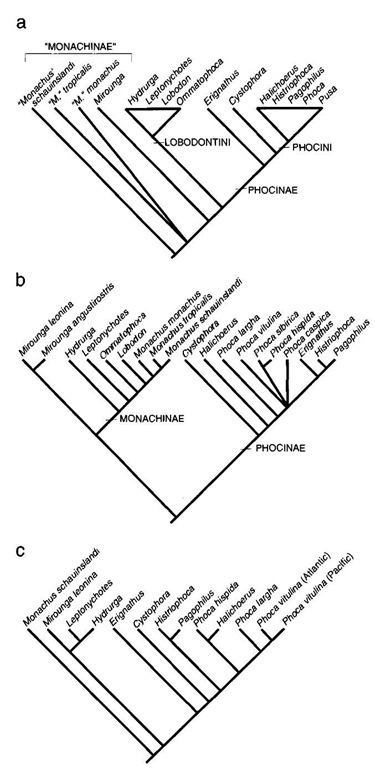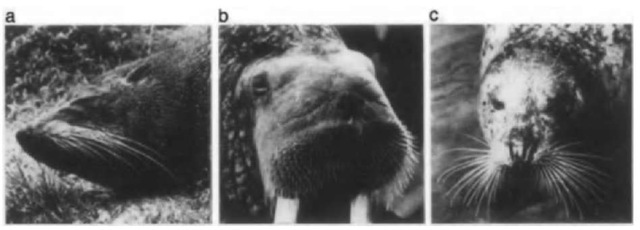Pinnipeds have always been understood to represent a group distinct from other aquatic mammals. They are recognized as members of the mammalian order Carnivore and include three monophyletic lineages; the Otariidae (fur seals and sea lions), the Odobenidae (the walruses), and the Phocidae (true or earless seals). Pinnipeds comprise slightly more than one-fourth (28%) of the species level diversity of marine mammals. Thirty-three to 37 living species of pinnipeds are distributed throughout the world: 18 phocids, 14-18 otariids, and the walrus. One additional species of modern phocid and a modern otariid are reported extinct in historical time (Rice, 1998).
I. Systematics and Distribution
A. Otariidae: Fur Seals and Sea Lions
Of the two groups of seals, otariids are characterized by the presence of external ear flaps or pinnae, and for this reason they are often called “eared” seals (Fig. 1). Otariids can turn their hind flippers forward and use them to walk. Otariidae typically are divided into two subgroupings: Otariinae (sea lions) and Arctocephalinae (fur seals). Five living genera and seven species of sea lions are recognized, occurring in both the Northern and Southern Hemispheres: Eumetopias jubata (northern sea lion), Neophoca cinerea (Australian sea lion), Otaria flavescens (southern sea lion), Zalophus californianus (California sea lion), Z. japonicus (Japanese sea lion), Z. ivollebacki (Galapagos sea lion), and Phocarctos hookeri (New Zealand sea lion; Fig. 2). Fur seals, named for their thick, dense fur, are divided into two genera. The genus Arctocephalus, or southern fur seals, consists of eight species: A. australis (South American fur seal), A. forsteri (New Zealand fur seal), A. gazella (Antarctic fur seal), A. galapagoensis (Galapagos fur seal), A. philippii (Juan Fernandez fur seal), A. pusillus (A. p. pusillus South African fur seal and A. p. doriferus Australian fur seal), A. townsendi (Guadalupe fur seal), and A. tropicalis (sub-Antarctic fur seal). The genus Callorhinus is monotypic; a single extant species is recognized, C. ursinus. All of the fur seals except the northern and Guadalupe fur seals are found in the Southern Hemisphere. The northern fur seal is found in subArctic waters of the North Pacific, with the exception of a small population on San Miguel Island off California (Fig. 3).
Figure 1 Representative otariids, (a) southern sea lion, Otaria flavescens, and (h) South African fur seal, Arctocephalus pusillus, illustrating pinna. Note also the thick, dense fur characteristic of fur seals. Males are shown behind smaller females. Illustrations by P. Folkens.
The monophyly of otariids is based on a combination of cranial, postcranial, and soft anatomical characters (Berta and Sumich, 1999). Relationships among otariids based on morphology conflict with those based on molecular data, although as yet the latter is based on an incomplete taxonomic sample (Fig. 4). Morphologic data indicate that only the sea lions (Otariinae) are monophyletic with a sister group relationship
Figure 2 Distribution map of sea lions.
Figure 3 Distribution map of fur seals.
Figure 4 Phylogeny of Otariidae based on morphologic data showing monophyletic Otariinae and paraphyletic “Arcto-cephalinae.”
One modern species of sea lion is probably extinct, Zalophus japonicus (Japanese sea lion); its last well-documented record of occurrence was in 1951.
B. Odobenidae: Walruses
Although tusks are arguably the most characteristic feature of the modern walrus, Odobenus rosmarus, a rapidly improving fossil record indicates that these unique structures evolved in a single lineage of walruses and “tusks do not a walrus make. ” The living walrus is the sole survivor of a what was once a diverse radiation of at least 10 genera and 13 species of walruses that lived from the early Miocene to the end of the Pliocene (Demere, 1994). Two subspecies of the modern walrus are recognized; O. r. rosmarus (Atlantic walrus) and O. rosmarus di-vergens (Pacific walrus). Pacific walruses are more abundant, are larger, and have longer tusks than Atlantic walruses (Fay, 1981). Walruses inhabit the Northern Hemisphere in areas with pack ice over shallow water of the continental shelf (Fig. 5). Like phocids, walruses lack external ear flaps. A unique feature of members of the modern walrus lineage are enlarged upper canine tusks that function primarily in breeding and social contexts. Walrus locomotion combines elements of phocid and otariid locomotion.
Monophyly of the walrus family is strongly supported, although there is controversy regarding whether walruses are related more closely to otariids or to phocids (Berta and Sumich, 1999). The modern walrus belongs to one of two monophyletic clades of walruses, the Odobeninae, and is most closely related to Valenictus, from the late Miocene to late Pliocene of southern and central California (Fig. 6). Several uniquely derived features of Valenictus indicate that it diverged from a common ancestry with Odobenus prior to pursuing its own evolutionary path toward toothlessness.
A survey of genetic variation among Atlantic and Pacific populations of the walrus suggests separation of the subspecies about 500,000-750,000 years ago, supporting the suggestion that Odobenus evolved in the Pacific and reached the North Atlantic early in Pleistocene time (Cronin et al, 1994).
Figure 5 Distribution of modern walrus subspecies, Odobenus rosmarus divergens (Pacific walrus) and Odobenus rosmarus rosmarus (Atlantic walrus).
C. Phocidae: Seals
The second major grouping of seals, the phocids, often are referred to as the “true” or “earless” seals for their lack of visible ear pinnae, a characteristic that readily distinguishes them from otariids as well as the walrus (Fig. 7). Among the most distinguishing phocid fur seals is their inability to turn the hindlimbs forward to support the body, resulting in a peculiar crawling locomotion on land. Phocids inhabit both Northern and Southern Hemispheres, although they are largely restricted to polar and subpolar regions (Fig. 8). Among pinnipeds, phocids are unique in their ability to survive in estuarine and freshwater habitats (e.g., Caspian and Baikal seals inhabiting land-locked lakes).
Traditionally, phocids have been divided into two or four major subgroups (including the Monachinae, Lobodontinae, Cystophorinae, and Phocinae). Only the Phocinae is universally accepted as being monophyletic (Berta and Sumich, 1999; Fig. 9).
The “Monachinae” subgroup of “southern seals” typically includes Monachus (monk seals), Mirounga (elephant seals), and the Lobodontini (Antarctic seals). Monophyly of the Monachinae is disputed (Wyss, 1988; Bininda-Emonds and Russell, 1996). Basal phocids have been identified as being Monachus spp. (not recognized as a monophyletic taxon by all workers) or alternatively as Mirounga. Three species of Monachus have been described: M. schauinslandi (Hawaiian monk seal), M. monachus (Mediterranean monk seal), and the recently extinct M. tropicalis (Caribbean monk seal). According to Wyss (1988), Monachus is a paraphyletic taxon, and based on morphology of the ear region, M. schauinslandi is basal to the other two species (Fig. 9a). Bininda-Emonds and Russell (1996) argue that Monachus is monophyletic and, on the basis of other morphologic characters, position M. monachus as the basal taxon (Fig. 9b). Molecular sequence data for species of Monachus are currently available only for M. schauinslandi and thus offer no resolution of relationships among this species group. Elephant seals, named for their enlarged proboscis, are represented by two species: Mirounga an-gustirostris (northern elephant seal) and Mirounga leonina (southern elephant seal).
There is also disagreement regarding monophyly of the Lobodontini, which include Leptonychotes weddellii (Weddell seal), Lobodon carcinophaga (crabeater seal), Hydrurga lep-tonyx (leopard seal), and Ommatophoca rossii (Ross seal). Although Wyss’ data support monophyly of this group, relationships among taxa were unresolved. According to Bininda-Emonds and Russell (1996) the Lobodontini are paraphyletic. Their most parsimonious tree (bootstrap analysis) supports a Lobodon-Monachus pairing with Ommataphoca, Leptony-chotes, and Hydrurga forming successive outgroups to this clade (Fig. 9b).
Figure 6 Phtlogeny of Odobenidae.
Figure 7 Representative “monachines” (a) Hawaiian monk seal, Monachus schanins-landi, and (b) northern elephant seal, Mirounga angustirostris, and phocines (c) harbor seal, Phoca vitulina, and (d) gray seal, Halichoerus grypus. Males are shown behind smaller females.
Traditionally the Phocinae subgroup of “northern seals” includes Erignathus barbatus (bearded seal), Cystophora cristata (hooded seal), Halichoems grypus (gray seal), Phoca (including among others harbor and spotted seal), Pusa hispida (ringed seal), Histriophoca fasciata (ribbon seal), and Pagophilus groen-landicus (harp seal). Wyss’ cladistic analysis supports Erignathus and Cystophora as successive sister taxa to the Phocini [Pusa, Histriophoca, Pagophilus, Halichoems, and Phoca). Although Bininda-Emonds found support for the basal position of Cystophora, this was not the case for Erignathus, which moved to a sister group relationship with Pagophilus + Histri-cophoca (Fig. 9b). There is disagreement about recognition of the Phocini; paraphyly of several taxa has been proposed based on both morphologic and molecular data. According to Arna-son et al. (1995) molecular data. Phocini are divided into an earlier diverging lineage consisting of Histriophoca and Pagophilus and the other composed of various species of Phoca (rendering the genus paraphyletic) and Halichoerus (Fig. 9c). Bininda-Emonds and Russell (1996) acknowledge weak support and poor resolution among Phocini.
The harbor seal (Phoca vitulina) has the most extensive geographic distribution of any seal, with a range spanning over 16,000 km from the east Baltic, west across the Atlantic and Pacific Ocean to southern Japan. The population structure of the harbor seal studied by Stanley et al. (1996) revealed that populations in the Pacific and Atlantic Oceans are highly differentiated. Mitochondrial data are consistent with the ancient isolation of populations in both oceans coincident with the development of continental glaciers and extensive sea ice. In the Atlantic and Pacific Oceans, populations appear to have been established from west to east, with the European populations showing the most recent common ancestry.
II. Anatomy and Physiology
Pinniped aquatic specializations include their streamlined shape, reduced external ear pinnae, paddle-like limbs and feet, small tail, and genital organs and mammary glands that are retracted beneath the skin. In comparison to most terrestrial car-nivorans, pinnipeds are large, which helps conserve warmth. Pinnipeds, particularly phocids show tremendous diversity in size, ranging from the smallest pinniped, the Baikal seal, Pusa sibirica, reaching a length of just over a meter and a weight of 45 kg to the largest pinniped, the elephant seals, nearly 5 m in length (adult males) and up to 3200 kg (Bonner, 1990). Pinnipeds are ecologically diverse with habitats ranging from shelf to surface waters in tropical and polar seas, with some species living in freshwater lakes, whereas others move freely between rivers and the ocean.
Phocids and the walrus have lost much of their hair (fur) and are characterized by thick layers of blubber under the skin. Otariids, especially fur seals, have retained a thick fur coat. Color patterns in the pelage of pinnipeds occur almost exclusively among phocids. Ice-breeding seals (e.g., ribbon seal, harp seal, hooded seal, ringed seal, crabeater seal, Weddell seal, and leopard seal) show contrasting dark and fight or disruptive color patterns (Fig. 10). The uniform coloration of some pinnipeds (e.g., white harp seal pups) allows them to blend readily into their arctic environment. Pinnipeds come ashore for birthing and molting. All phocid seals undergo an annual molt. Fur seals and sea lions instead renew their pelt gradually all year.
Vibrissae. or whiskers, are stiff hairs that occur on the face. Most prominent are the mystacial whiskers, which range in size from the short stiff bristles of the walrus to the very long, fine bristles of fur seals (Fig. 11). Vibrissae function as sensitive touch receptors. Research on the Baltic ringed seal (P. hispida) has shown that they have exceptionally well-developed vibrissae, which help them find their way in the dark and often cloudy water beneath the ice (Hyvarinen, 1995). A single vibrissae of the Baltic ringed seal contains more than 10 times the number of nerve fibers typically found in that of a land mammal.
Figure 8 Distribution of some Arctic phocines. (a), Antarctic lobodontine and phocines (b), and “monachines” (c).
Figure 9 Alternative phytogenies for Phocidae based on morphologic data (a) from Wyss (1988) and Berta and Wyss (1994); (b) from Bininda-Emonds and Russell (1996); and (c) molecular data from Arnason et al. (1995).
Pinnipeds, like other marine mammals, have evolved ways to accommodate the immense heat loss that occurs in the water. Among these solutions are a spherical body and a resultant decreased surface-to-volume ratio and increased insulation (thick blubber or fur). In addition, heat exchange systems occurring in the flippers, in the fins, and (as discovered recently) in the reproductive tracts of pinnipeds conserve body heat.
Among modem pinnipeds, aquatic and terrestrial locomotion are achieved differently. Three distinct patterns of swimming are recognized: (1) pectoral oscillation (forelimb swimming) seen in otariids where the forelimbs are used in a “flapping” manner to produce thrust, (2) pelvic oscillation (hindlimb swimming) seen in phocids where the hindlimbs are the major propulsors, and (3) a variant of pelvic oscillation exhibited by the walrus where the hindlimb are the dominant propulsive force and the forelimbs are used as rudders or paddles. There is a major difference in locomotion on land between phocids on the one hand and otariids and walruses on the other. The inability of phocids to turn the hindlimbs forward results in forward progression by vertical undulations of the tnink, which do not involve the hindlimbs. In walruses, as in otariids, the hindlimbs can be rotated forward in terrestrial locomotion.
Figure 10 Examples of phocid pelage patterns: (a) Weddell seal, Leptonychotes weddellii; (b) leopard seal, Hydrurga lep-tonyx; (c) hooded seal, Cystophora cristata, male in back; (d) ribbon seal, Histriophoca fasciata; and (e) ringed seal, Pusa hispida.
Figure 11 Heads of various pinnipeds showing facial vibrissae: (a) New Zealand fur seal, Arctocephalus forsteri, (b) walrus, Odobenus rosmarus, and (c) Pacific harbor seal, Phoca vitulina richardii.
Pinnipeds are carnivores; most are generalists feeding predominantly on fish and squid. Several pinnipeds, notably crabeater and leopard seals, have highly modified cheek teeth with complex cusps to trap and strain krill. Leopard seals also possess well-developed canines for preying on birds and other pinnipeds. Walruses are specialists that feed almost exclusively on clams using a suction-feeding strategy in which the muscular tongue acts as a piston, creating low pressure in the mouth cavity. Some pinnipeds, e.g., elephant seals, rival gray whales (Esch-richtius robustus) in the distances traveled in migration (18,000-21,000 km) to forage offshore between breeding seasons. The advent of microprocessor-based time and depth recorders and satellite telemetry has enabled the documentation of details of the foraging behavior of diese deep-diving seals.
Among pinnipeds are found the most extraordinary of marine mammal divers. Average dives of small species such as the Ross seal are just under 10 min in duration, increasing to over 1 hr for the northern elephant seal and the Weddell seal. Maximum depths vary from less than 100 m in the Guadalupe fur seal to more than 1500 m in northern elephant seal males. Some seals (in addition to sperm whales Physeter macrocephalus, sea turtles, and some penguins) are “incredible diving machines” with unique ways of budgeting their oxygen supply and responding to pressure.
Sounds produced by pinnipeds include air-borne and underwater vocalizations. Air-borne sounds vary from grunts, snorts, or barks identified as either mother-pup calls or threat calls among seals to the distinctive gong-like sounds produced by male walruses striking throat pouches with their flippers as part of a courting display during the breeding season. Pinnipeds produce a variety of underwater sounds that appear related to breeding activities and social interactions. Among these are the whistles, trills, chirps, and buzzes of Weddell seals diat are used in territorial defense. These contrast with the soft lyrical calls of leopard seals that may be related to their solitary social system.
In contrast to toothed whales, pinnipeds have not been found to use echolocation in their natural surroundings.
The pinniped eye is adapted for vision both above and under water. The spherical lens, thick retina, and the well-developed tapetum lucidum increase light sensitivity. With the exception of the walrus, which has small eyes, seals and sea lions have large eyes in relation to body size. The question of whether pinnipeds have color vision is still debated, although behavioral experiments and the presence of both rods and cones in the retina have been documented in some species (e.g., California sea lion, spotted seal, walrus).
III. Behavior
Unlike other marine mammals, pinnipeds differ in their need to return to land (or to ice) to give birth. Many pinnipeds (e.g., elephant seal) are extremely polygynous, with successful males mating with dozens of females in a single breeding season. Species that are polygynous tend to breed in large colonies on land where males compete for breeding territories (in otariids) or establish dominance hierarchies (in elephant seals). Because these males must compete for access to females, associated with extreme polygyny is the strong sexual dimorphism seen in elephant seals, including large body size (adult males as much as five times as large as females), elongated proboscis, enlarged canine teeth, and thick skin on the neck. Other phocids (e.g., Weddell seal, harp, ringed, ribbon, bearded, hooded) mate in the water or on ice and show a reduced level of polygyny, which is explained in part by the difficulty in gaining access to females in unstable environments such as pack ice.
Pinnipeds are characterized by sexual bimaturity with females reaching sexual maturity before males. In polygynous species, males require several years of physical maturation following sexual maturity before they successfully compete for access to females. Gestation in most species of pinnipeds averages between 10 and 12 months; walruses have the longest gestation period of 16 months. Most species regulate their reproductive cycle by delayed implantation (from 1.5 to 5 months). Delayed implantation prolongs birth until conditions are more favorable for offspring survival. Pinniped females of all species give birth to a single pup. In most species, pupping occurs in spring or summer.
The maternal behaviors and lactation strategies of pinnipeds are influenced by their breeding habitat whether on ice or land. Most phocids exhibit a fasting strategy where females fast completely and remain out of water for the duration of a relatively short lactation, ranging from less than 1 week in hooded seals to almost 8 weeks in the Weddell seal. It has been suggested that the unstable nature of pack ice has selected for the extremely short lactation periods of some ice-breeding phocid seals. To compensate for the brevity of lactation, the milk produced by these species is energy dense, with a fat content up to 60% in some species (i.e., hooded and harp seals). Rapid pup growth is ensured by the richness of the milk. In the foraging cycle strategy of most otariids, mothers fast for only a few days following the birth of pups. Then the mothers begin foraging trips at sea, leaving their pups for a few days at a time. The lactation period of otariids are longer, ranging from several months to more than 1 year, and milk is generally less energy dense than in phocids (e.g., milk fat content averaging between 24 and 40%). Walruses exhibit a variant of the otariid strategy, termed the aquatic nursing strategy, in which walrus pups accompany their mothers on foraging trips into the water. The length of lactation in walruses is the longest among pinnipeds, lasting 2 or 3 years.
Among generalizations that can be made about pinniped longevity is that females, especially those of polygynous species, tend to live longer than males. In many cases, males do not survive even to the delayed age of sexual maturity. Seals have been known to pup successfully at 24-25 years and live as long as 40 years or more. Significant factors implicated in the natural mortality of pinnipeds include disease (especially morbil-liviruses), predation (e.g., white sharks, killer whales), starvation, and parasites.
